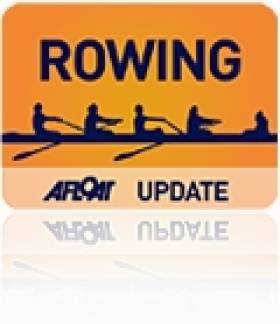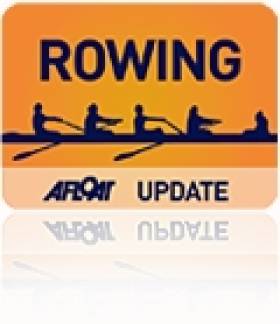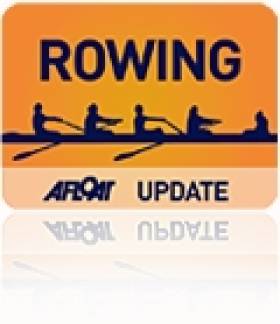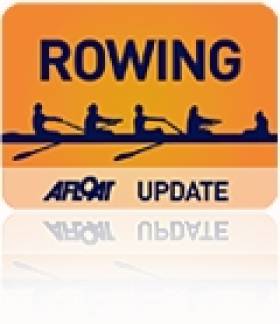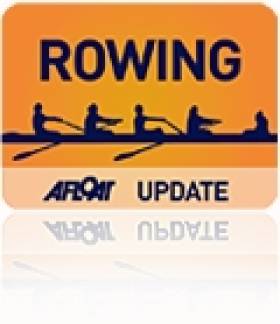Displaying items by tag: trials
Rowing Pair of Dilleen and Kennedy Make Mark at Trials
#ROWING: The newly-formed women’s pair of Lisa Dilleen and Leonora Kennedy were outstanding in racing on the final day of the Ireland Trials at the National Rowing Centre. Their percentage of projected World Championship gold medal winning time was an excellent 88.25. The new lightweight men’s pair of Mark O’Donovan and Niall Kenny and single scullers Paul O’Donovan and Sanita Puspure also breached 87 per cent. All these crews are set to represent Ireland this year.
On Saturday, in the Home International Trials, Eimantas Grigalius, the former world junior champion for Lithuania who now lives in Ireland, topped the rankings in the single sculls.
Ireland Trials, National Rowing Centre, Cork
Saturday (Home International Trials)
Men
Pair – Senior: 1 Buckley/Coughlan 7:52.57 (74.06), 2 Rawlinson/Brett 7:53.86 (73.86), 3 Deere/Corcoran 7:57.32 (73.33).
Lightweight Pair: Keene/Breen 7:48.69 (74.68), 2 Murphy/McKenna 7:49.77 (74.5)
Junior Pair: 1 Browne/O’Connor 7:54.10 (73.82), 2 Higgins/Higgins 7:55.62 (73.59), 3 Coyne/McCarthy 7:57.33 (73.32).
Single Sculls – Senior: 1 E Grigalius 7:51.56 (78.46), 2 D Neale 7:59.09 (77.23), 3 S McKeown 8:04.84 (76.31).
Lightweight Single Sculls – Senior: N Duncan 8:21.96 (75.70), 2 C Murphy 8:41.5 (72.78), 3 S Toland 8:49.20 (71.81)
Junior Single Scull: 1 D Synott 8:04.76 (76.33), 2 S Dennehy 8:11.55 (75.27), 3 S O’Sullivan 8:12.87 (75.07).
Women
Pair - Senior: 1 Lonergan/Ryan 8:47.30 (73.58), 2 O’Brien/McCarthy 8:48.73 (73.38), 3 Bracken/Kelly 8:59.77 (71.88).
Lightweight Pair – Senior: 1 Leahy/Crowe 8:36.85 (77.78), 2 Wickham/Judge 8:51.01 (75.70).
Junior Pair: Connor/Hickey 8:44.08 (74.03), 2 Davis/O’Dwyer 8:51.97 (72.94), 3 O’Keeffe/Nagle 8:55.28 (72.49).
Lightweight Single Sculls – Senior: 1 E Desmond 9:18.30 (74.87), 2 O Holden 9:40.27 (72.04), 3 A Bulman 9:43.64 (71.62).
Junior Single Scull: 1 A Rodger 9:03.29 (73.99), 2 S Murphy 9:03.99 (73.9), 3 M McLaughlin 9:05.29 (73.72).
Sunday
(Per Centages Based On Senior Times)
Race One: 1 B Keohane, D Keohane (junior pair) 7:34.12 (81.04), 2 P O’Donovan (lightweight single, under-23) 7:37.78 (87.38), 3 L Kennedy, L Dilleen (women’s senior pair) 7:40.89 (88.25), 4 O Hayes, C Jennings (women’s lightweight double) 7:51.38 (85.71).
Race Two: 1 S Dolan (women’s lightweight single) 8:50.00 (83.02), S Horgan (women’s lightweight single, under-23) 8:51.63 (82.76), 3 E Barry (jun women’s single) 8:52.99 (79.74), 4 E Hegarty (jun women’s single) 9:06.59 (77.75)
Race Three: 1 J Ryan (lightweight single) 7:53.65 (84.45), 2 Women’s Junior Double (J English, E Lambe) 8:02.67 (81.63), 3 S Puspure (women’s single) 8:05.73 (87.5), 4 Women’s Junior Double (O’Keeffe) 8:16.75 (79.32).
Race Four: 1 Lightweight Pair (M O’Donovan, N Kenny) 7:15.87 (87.18), 2 Women’s Four (M O’Neill, E Tormey, B O’Brien, A Keogh) 7:31.87 (84.09), 3 D Neale (men’s single) 7:56.54 (81.84), 4 J Keohane (men’s single) 7:59.85 (81.28).
Race Five: 1 Men’s Double (S McKeown, D Quinlan) 7:12.90 (82.93), 2 Men’s Double (Oliver) 7:17.73 (82.01), 3 Men’s Pair (R O’Callaghan, R Bennett) 7:28.26 (82.10), 4 Men’s Pair (K Neville, M Pukelis) 7:31.51 (81.5).
Race Six: 1 Junior Quadruple (Begley) 6:58.49 (79.09), 2 Lightweight Double (C Beck) 7:11.04 (84.91), 3 Junior Double (D O’Malley, C Carmody) 7:12.49 (83.01), 4 Junior Double (Mulvaney) 7:19.14 (81.75).
Race Seven (Pararowing Crews, 1,000m): 1 LTA1x (O’Hara) 2:09.42 (77.27), 2 TA1x (O’Brien) 2:45.40 (81.62), 3 AS1x (O’Doherty) 2:48.06 (81.82), 4 AS1x (Kelly) 3:09.52 (72.55).
Headwind No Problem for O'Donovan and Puspure
#ROWING: Paul O’Donovan and Sanita Puspure headed the rankings on the first day of the Ireland Trial at the National Rowing Centre in Cork today. O’Donovan, who is still just 19 and a lightweight, was the fastest single sculler on the water. In sometimes difficult headwind conditions he hit 85.5 per cent of projected world gold medal winning time for an under-23 lightweight. Puspure was the fastest woman and her per centage as an openweight single sculler was 84.42.
Ireland Trials, National Rowing Centre, Cork (Selected Results (provisional); Ranked by Time and Per Centage of projected World Gold Medal Time)
Men
Pair – Under-23: 1 M Pukelis, K Neville 7:19.33 (79.67), 2 R O’Callaghan, R Bennett 7:20.13 (79.52). Junior: 1 B Keohane, D Keohane 7:24.93 (78.66), 2 E Murray, B Rix 7:39.46 (76.18), 3 K Fallon, J Bennett 7:41.17 (75.89).
Sculling, Single – Senior: 1 J Keohane 7:31.69 (81.91 per cent), 2 D Neale 7:45.56 (79.47). Under-23: 1 A Harrington 7:33.35 (81.61), 2 D Quinlan 7:46.62 (79.29), 3 T Oliver 7:50.01 (78.72).
Lightweight Single – Under-23: 1 P O’Donovan 7:24.47 (85.50), 2 S O’Driscoll 7:33.88 (83.72), 3 B Beck 7:40.24 (82.57).
Junior: 1 D O’Malley 7:39.10 (80.59), 2 C Carmody 7:43.20 (79.88), 3 S Mulvaney 7:49.15 (78.87).
Women
Pair – Junior: 1 N Casey, E McCarthy 8:28.74 (76.27), 2 Clarke, Glover 8:36.22 (75.16), 3 O’Connor, Hickey 8:40.66 (74.52).
Sculling, Double – Senior: E Moran, M Dukarska 7:41.83 (81.05)
Single – Senior: S Puspure 7:56.20 (84.42)
Lightweight Single – Senior: 1 S McCrohan 8:21.77 (83.31), 2 O Hayes 8:30.20 (81.93), 3 C Jennings 8:31.52 (81.72).
Junior: 1 E Barry 8:32.96 (78.37), 2 E Lambe 8:43.60 (76.78), 3 E Hegarty 8:48.04 (76.13).
Ireland Rowing Trials May Be Cut Short
#ROWING: The Ireland trials on Newry Canal this weekend may be altered because of the forecast of bad weather. Time trials are scheduled for both days over five kilometres, but the distance on Sunday might be cut to 2.5 km. The hope is to use the more sheltered part of the course.
Meanwhile, the Cork Head of the River is now set to be held on March 8th. The interest in the Erne Head of the River on March 1st is impressive, with 77 crews entered.
Ireland Rowing Trials Programme Announced
#RowingIrelandProgramme: The trials process for Ireland crews will begin next month. Crews will be formed much earlier than in recent years and athletes who do not make the World Cup or World Championships squads will be facilitated.
There are four stages:
- An ID Trial at the National Rowing Centre in Cork, September 28th, 2013 which will feature on-the-water testing and will indentify a senior squad for World Cup Regattas and World Championships and development groups at senior, under-23 and junior level.
- Ergometer Tests over 2,000 metres on 23rd November (Limerick) and 30th November (Belfast). These are compulsory save on medical grounds or in exceptional circumstances
- Assessment over 5000m on Newry Canal for invited athletes on February 22nd and 23rd
- Final Selection of World Championships crews, March 22nd and 23rd at National Rowing Centre (junior crews to be formed and tested in regattas)
Athletes based abroad, and those with other valid reasons for not going through this process (including late-developing athletes) can be excepted.
Dolan and O'Donovan Shine at National Trials
Sarah Dolan, an under-23 lightweight, and Paul O’Donovan, a junior athlete, topped the rankings at the National Rowing Trials at the National Rowing Centre in Cork and made the A Finals of the single scull. Dolan registered 96.3 per cent of projected world gold medal winning time, while O’Donovan hit a mark or 95.7 per cent.
National Trials, National Rowing Centre, Cork (percentages in brackets of estimated world gold-medal winning time for the athlete’s grade). Senior athletes lightweight unless stated.
Men, Semi-Finals (First Three to A Final; rest to B Final)
Pair – A/B Semi-Final One (all juniors): 1 J Cassells, C Black 6:52.5 (94.1), 2 J Egan, A Kelly (7:03.2), 3 E Beechinor, K Synnott 7:03.6 (91.6); 4 C O’Riada, K Doyle 7:05.7 (91.2), 5 D Buckley, J Mitchell 7:15.2 (89.2).
A/B Semi-Final Two: 1 C Egan, F Tolan 6:57.4 (93.0), 2 L Seaman, H Millar 7:04.0 (91.5), 3 D Hindle, A Bell 7:05.3 (91.3); 4 S Hewitt, P Boomer 7:08.3 (90.6).
Sculling, Single - Semi-Final A/B One: 1 M Maher 7:06.0 (senior; 93.3 per cent), 2 S O’Driscoll 7.08.2 (under-23; 95.1), 3 P O’Donovan 7:o9.7 (junior; 95.7); 4 A English 7:11.4 (92.1), 5 J Mitchell 7:19.3 (92.7), 6 D Quigley 7:26.2 (92.2)
Semi-Final A/B Two: 1 M O’Donovan 7:07.9 (senior; 92.9), 2 N Kenny 7:09.2 (under-23; 94.9), 3 P Hanily 7:09.3 (under-23; 7:09.3); 4 J Ryan 7:10.7, 5 A Sheehan 7:29.6 (under-23; 91.5), 6 N Prenderville 7:32.5 (under-23; 90.9) * Ryan Goes Through to A Final, due to effect of launch.
C/D Semi-Final (all juniors) First Three To C Final – Semi-Final One: 1 M Monteith 7:24.6 (92.5), 2 P Hegarty 7:27.2 (92.0), 3 M Ryan 7:32.4 (90.9); 4 B Wilson 7:36.8 (90.1), 5 B Looney 7:38.4, 6 D Aherne 7:38.5 (89.7). C/D Semi-Final Two: 1 D Collins 7:29.1 (91.6), 2 A Griffin 7:31.7 (91.1), 3 C Kelly 7:32.3 (91.0); 4 P Leonard 7:35.1 (90.4), 5 J Casey 7:41.1 (89.2).
Women,
Single Scull – A/B Semi-Final One: 1 S McCrohan 7:43.9 (senior; 94.2), 2 C Lambe 7:50.9 (under-23; 7:50.9), 3 E Moran 7:55.4 (open senior; 88.8); 4 O Hayes 8:00.6 (senior; 91.0), 5 S Dineen 8:03.0 (junior; 93.4), 6 Sinead Dolan 8:15.9 (under-23; 90.4).
A/B Semi-Final Two: 1 Sarah Dolan 7:45.5 (under-23; 96.3), 2 L Dilleen 7:46.1 (u-23; 92.8), 3 D Walsh 7:49.5 (u23; 95.5); 4 H Nixon 7:54.5 (junior; 95.1), 5 C Deasy 8:12.2 (junior; 91.7), 6 R Shorten 8:16.2 (90.9).
C/D Semis (all juniors) – Semi-Final One: 1 K Cromie 8:09.5 (92.2), 2 L Litvack 8:16.3 (90.9), 3 K O’Brien 8:17.9 (90.6); 4 N O’Mahony 8:23.1 (89.7), 5 B Walsh 8:23.3 (89.6), 6 S Allen 8:26.9 (89.0). Semi-Final Two: 1 H Shinnick 8:10.7 (91.7), 2 B Jacques 8:12.7 (91.6), 3 L Connolly 8:17.0 (90.8); 4 G Hosford 8:17.1 (90.2), 5 L Hamel 8:22.7 (89.7).
Craftinsure Sponsor Royal St. George Junior Event
Dun Laoghaire's Royal St. George Yacht Club has announced that its inaugural Junior Spring Open, sponsored by Craftinsure, will be held on the 19th & 20th of March 2011. This event promises to be a great kick start to the Junior Sailing Season for the Optimist, 420, Feva and Laser Classes.
There will be both Regatta and Main Fleets, Regatta Coaches on the courses and the event will count as an Optimist Pre-Trials and Pre-Regional event. With the ISA Mitsubishi Youth National Championship being held in the same sailing area at the end of April, this event is a great opportunity for sailors from all around the country to get some practise in the local waters.
There will be entertainment for sailors and parents on both evenings, evening dinners and, of course, full Six Nations Rugby coverage on the Saturday throughout the Club. There will also be live-tweeting from the water throughout the event - follow this live action unfold at www.twitter.com/rsgyc.
For further information and to enter online please visit www.rsgyc.ie. The Entrance Fee is €85 for Fevas & 420s and €55 for Oppies & Lasers.
Selection Procedure for Team Racing Worlds Underway
The selection procedure to designate the teams to represent Ireland at the ISAF Team Racing Worlds is underway.
Teams wishing to be considered for selection should contact the Irish Team Racing Association a [email protected]. A selection committee will then invite teams to trials to be sailed early in 2011. Invitations will be issued on the basis of the results of all team members (helm and crew) in 2009 -2010.
The trials will consist of a multiple round robin event. The Youth trials will be sailed in Crosshaven, and the senior trials in Dun Laoghaire. Unfortunately, the number of places available for Ireland at the World Championships is not yet known, but ITRA will select two senior teams, plus a reserve team, and two Youth teams, plus a reserve.



























